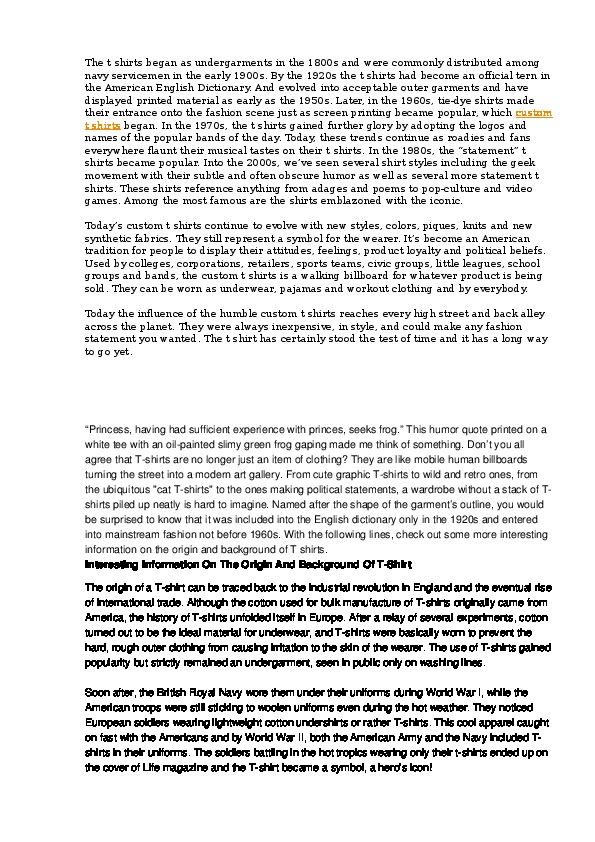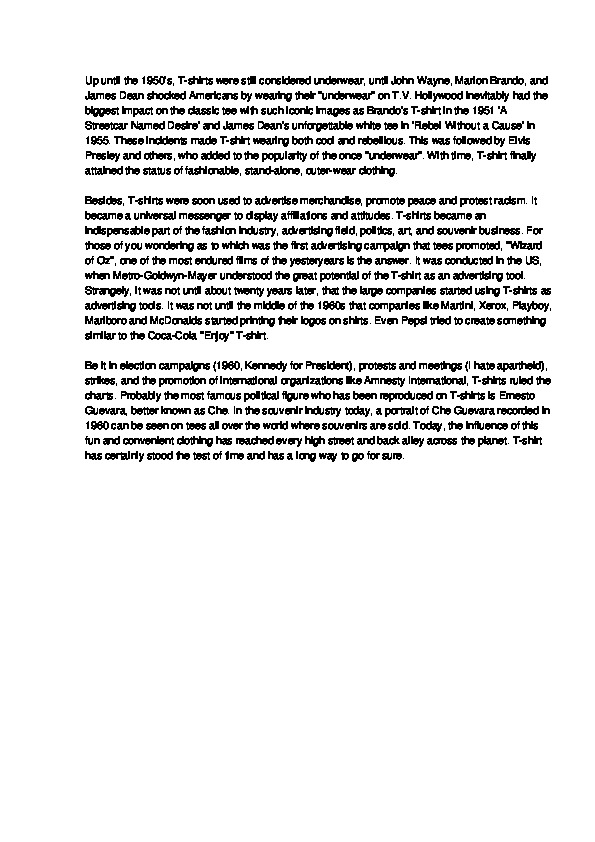The t shirts began as undergarments in the 1800s and were commonly distributed among navy servicemen in the early 1900s. By the 1920s the t shirts had become an official tern in the American English Dictionary. And evolved into acceptable outer garments and have displayed printed material as early as the 1950s. Later, in the 1960s, tie-dye shirts made their entrance onto the fashion scene just as screen printing became popular, which custom t shirts began. In the 1970s, the t shirts gained further glory by adopting the logos and names of the popular bands of the day.
The t shirts began as undergarments in the 1800s and were commonly distributed among
navy servicemen in the early 1900s. By the 1920s the t shirts had become an official tern in
the American English Dictionary. And evolved into acceptable outer garments and have
displayed printed material as early as the 1950s. Later, in the 1960s, tie-dye shirts made
their entrance onto the fashion scene just as screen printing became popular, which custom
t shirts began. In the 1970s, the t shirts gained further glory by adopting the logos and
names of the popular bands of the day. Today, these trends continue as roadies and fans
everywhere flaunt their musical tastes on their t shirts. In the 1980s, the “statement” t
shirts became popular. Into the 2000s, we’ve seen several shirt styles including the geek
movement with their subtle and often obscure humor as well as several more statement t
shirts. These shirts reference anything from adages and poems to pop-culture and video
games. Among the most famous are the shirts emblazoned with the iconic.
Today’s custom t shirts continue to evolve with new styles, colors, piques, knits and new
synthetic fabrics. They still represent a symbol for the wearer. It’s become an American
tradition for people to display their attitudes, feelings, product loyalty and political beliefs.
Used by colleges, corporations, retailers, sports teams, civic groups, little leagues, school
groups and bands, the custom t shirts is a walking billboard for whatever product is being
sold. They can be worn as underwear, pajamas and workout clothing and by everybody.
Today the influence of the humble custom t shirts reaches every high street and back alley
across the planet. They were always inexpensive, in style, and could make any fashion
statement you wanted. The t shirt has certainly stood the test of time and it has a long way
to go yet.
“Princess, having had sufficient experience with princes, seeks frog.” This humor quote printed on a
white tee with an oilpainted slimy green frog gaping made me think of something. Don’t you all
agree that Tshirts are no longer just an item of clothing? They are like mobile human billboards
turning the street into a modern art gallery. From cute graphic Tshirts to wild and retro ones, from
the ubiquitous "cat Tshirts" to the ones making political statements, a wardrobe without a stack of T
shirts piled up neatly is hard to imagine. Named after the shape of the garment’s outline, you would
be surprised to know that it was included into the English dictionary only in the 1920s and entered
into mainstream fashion not before 1960s. With the following lines, check out some more interesting
information on the origin and background of T shirts.
Interesting Information On The Origin And Background Of TShirt
The origin of a Tshirt can be traced back to the industrial revolution in England and the eventual rise
of international trade. Although the cotton used for bulk manufacture of Tshirts originally came from
America, the history of Tshirts unfolded itself in Europe. After a relay of several experiments, cotton
turned out to be the ideal material for underwear, and Tshirts were basically worn to prevent the
hard, rough outer clothing from causing irritation to the skin of the wearer. The use of Tshirts gained
popularity but strictly remained an undergarment, seen in public only on washing lines.
Soon after, the British Royal Navy wore them under their uniforms during World War I, while the
American troops were still sticking to woolen uniforms even during the hot weather. They noticed
European soldiers wearing lightweight cotton undershirts or rather Tshirts. This cool apparel caught
on fast with the Americans and by World War II, both the American Army and the Navy included T
shirts in their uniforms. The soldiers battling in the hot tropics wearing only their tshirts ended up on
the cover of Life magazine and the Tshirt became a symbol, a hero’s icon!Up until the 1950’s, Tshirts were still considered underwear, until John Wayne, Marlon Brando, and
James Dean shocked Americans by wearing their “underwear” on T.V. Hollywood inevitably had the
biggest impact on the classic tee with such iconic images as Brando's Tshirt in the 1951 'A
Streetcar Named Desire' and James Dean's unforgettable white tee in 'Rebel Without a Cause' in
1955. These incidents made Tshirt wearing both cool and rebellious. This was followed by Elvis
Presley and others, who added to the popularity of the once “underwear”. With time, Tshirt finally
attained the status of fashionable, standalone, outerwear clothing.
Besides, Tshirts were soon used to advertise merchandise, promote peace and protest racism. It
became a universal messenger to display affiliations and attitudes. Tshirts became an
indispensable part of the fashion industry, advertising field, politics, art, and souvenir business. For
those of you wondering as to which was the first advertising campaign that tees promoted, “Wizard
of Oz”, one of the most endured films of the yesteryears is the answer. It was conducted in the US,
when MetroGoldwynMayer understood the great potential of the Tshirt as an advertising tool.
Strangely, it was not until about twenty years later, that the large companies started using Tshirts as
advertising tools. It was not until the middle of the 1960s that companies like Martini, Xerox, Playboy,
Marlboro and McDonalds started printing their logos on shirts. Even Pepsi tried to create something
similar to the CocaCola “Enjoy” Tshirt.
Be it in election campaigns (1960, Kennedy for President), protests and meetings (I hate apartheid),
strikes, and the promotion of international organizations like Amnesty International, Tshirts ruled the
charts. Probably the most famous political figure who has been reproduced on Tshirts is Ernesto
Guevara, better known as Che. In the souvenir industry today, a portrait of Che Guevara recorded in
1960 can be seen on tees all over the world where souvenirs are sold. Today, the influence of this
fun and convenient clothing has reached every high street and back alley across the planet. Tshirt
has certainly stood the test of time and has a long way to go for sure.


